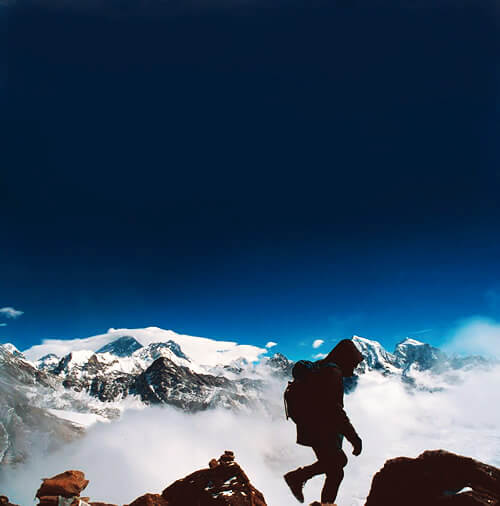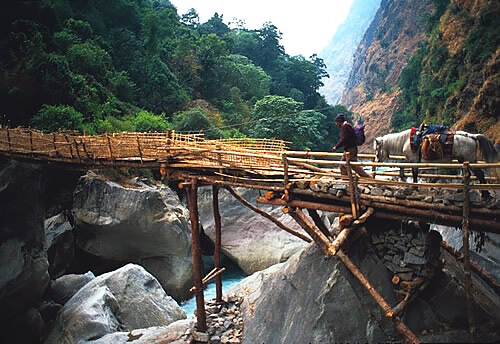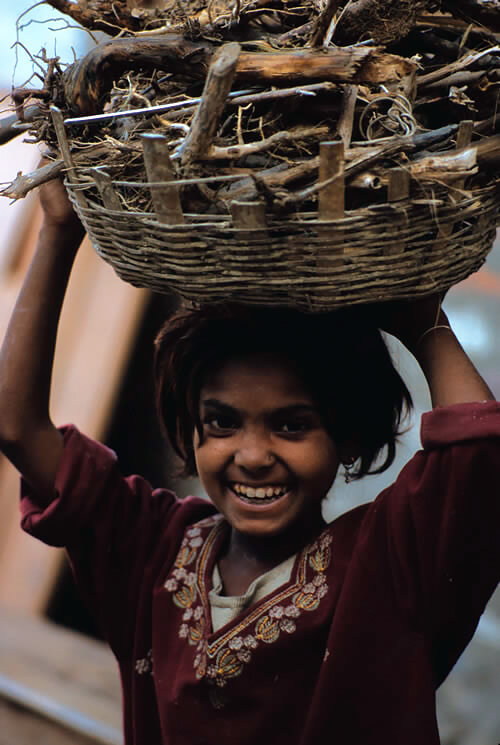Adventures Trekking the Himalayas
Exploring Remote Regions of Nepal
Article and photos by Larry Morgan
 |
| A trekker in Nepal. |
The Himalayas have isolated Nepal from the Western world for centuries, and even today the ruggedness of these mountains continues to insulate the people, customs, and religions of this unusual land from the influence of
the industrialized world. There are few roads extending into the Himalaya, and it is necessary to walk for days or even weeks to reach many destinations.
For the adventure traveler seeking wild country, this lack of transportation is considered an advantage rather than an obstacle. Nepal’s combination of natural beauty and unique cultures reveal themselves only to those
who hike into its rugged mountains.
Trekking is not a wilderness adventure. The mountains in Nepal have been inhabited for centuries. The routes through these hills have been well traveled by Nepalese for many generations, and sharing the trails with the local
people greatly enhances the journey.
Trekking is a cultural experience. The traveler is completely immersed in the culture and in touch with the people, environment, and wildlife. One of the joys of traveling is talking with the Nepalese, many of whom speak
English and are happy to explain their culture and the natural history of the countryside.
Although trekking alone is not entirely recommended, I have trekked solo on more than 20 journeys into the Himalayas — a month or two at a time — and never had a problem. I feel it is safer here than in my own country.
It is not an easy undertaking, but anyone in reasonable physical condition with some backpacking experience can do an extended trip into the Himalayas.
I like to travel by what is often called the “live off the land” method. Along the major routes, such as the Everest Trek or the Annapurna Circuit, each small village in the mountains has lodging of some sort.
Today’s lodges along the Himalayan trails originated from the “bhatti,” which have been in existence for centuries. It has always been necessary for porters and travelers along these trade routes to have lodging, and a bhatti
provided this for a small amount of money.
 |
|
There are no roads in the Everest trekking region of Nepal, near Namche Bazaar, the gateway to the high Himalaya; all things that cannot be produced from the land are brought in on the backs of porters, who carry heavy
loads to earn a cash income that helps support their families, and in some cases augments subsistence farming.
|
Travel agents can arrange guided treks with porters, cooks, and tents, but I prefer to travel on my own. For a small price I get to stay in a small lodge, where I may be the only guest. I have a place to unroll my sleeping
bag, a good dinner, warmth, cheer, and good company with my Nepalese hosts. It is possible for the traveler to take extended trips here for months at a time without re-supplying nor carrying a tent, cooking gear, or food.
The items I recommend bringing from home are a warm sleeping bag, your own well-worn hiking boots, and as many socks as possible. Bringing other personal equipment that you feel comfortable using is a good idea too, if you
can fit it in your luggage. On the other hand, you can purchase most of the equipment you need in either the Thamel section in Kathmandu or in Phokara. Items in these tourist areas tend to be cheap, of poor quality, and only last the duration
of one trek — but this makes it a perfect place for picking up small items needed on the trail, such as a hat, gloves, and sunglasses.
Although I usually budget about $20 a day for my time in the mountains, I find it often costs far less — sometimes as little as $10 per day. On occasion I have bargained the price of my room, but I find that too often
trekkers try to bargain the Nepalese down to the lowest rupee they can get. The Nepalese find this frustrating although they accept it with smiling resignation. If the first price seems reasonable, I usually don’t bargain at all. I find
that if I don’t bargain, I get a lot more out of the experience. The total price for my overnight stay may end up costing a dollar more, but my hosts are far friendlier and will often go out of their way to show me something unusual. They
may show me their beehive and then make me a chapatti with their own honey, let me help them butcher a goat, or show me some ancient Tibetan jewelry that belonged to their great grandmother. Trekking in Nepal is not an expensive journey, and
what is a small amount to you is a significant amount for the local economy.
There is a peak tourist season, during October and early November, when there can be a lot of trekkers along the Mount Everest and Annapurna Circuit trails. But trekking between December and February is surprisingly quiet
even along these main trails. January brings snow and cold in the high mountain passes, and the winter landscape can be hauntingly beautiful. I do all my trekking in these off-season months. The monsoon season — between June and September — is
wet, with frequent mudslides, and bloodsucking leeches on the trail.
Finding your way through the mountains can take some ingenuity, although often the trail follows broad river valleys and is easy to follow. I often ask Nepalese for directions, and I also use maps and guidebooks. Along the
main trails where trekkers are a familiar sight, local people will make sure you are going in the right direction and will often call out if you are on the wrong track.
 |
Along Nepal’s Annapurna Circuit trekking trail: crossing a bamboo bridge with a team of donkeys. |
Because of the ruggedness of Himalayan travel — the steep ups and downs, river crossings, altitude, and erratic weather — distances are meaningless. Instead of using measurements to explain how far a destination
is, Nepalese think in terms of time. For instance, they will say it is two hours to the top of the pass, or an hour to the next village, or three days’ walk to Kathmandu.
Many times local people have stopped to warn me of hazardous situations — the trail ahead may be too narrow to walk, or an avalanche may have wiped it out entirely. I always take this advice seriously. Nepalese mountain
people are able to travel easily through terrain that I may find nearly impossible, and I have sometimes had to re-route through a much longer trail in order to avoid dangerous conditions.
 |
This young girl has been gathering small pieces of wood from the forest to be used as fire wood for cooking and heating. She carries the basket on her head, typical of the people in Janakpur, the flat plains area of southern
Nepal. |
First-time trekkers in Nepal would probably be best to choose one of the main trails. They are popular for good reason: they offer dramatic mountain scenery and unique cultures. It is easy to get to the trailhead from Kathmandu,
and trekking here requires only a minimum amount of pre-trip planning.
Outside the main trekking trails, Nepal is almost completely untouched by tourism. Trekking off the main trails is not only possible, but it is also immensely rewarding and a chance to experience a completely different way
of life. But I would highly recommend going on one of the standard treks first, unless you have some experience traveling in third world countries, or you decide to travel with a guide and porter.
A reasonable amount of time to spend on the trail is two weeks to a month, although many find they enjoy trekking so much that they return again and again. It is possible for the hardcore traveler to gypsy around the trails
for half a year or longer. It is important to remember that trekking is a process rather than a destination: immerse yourself in the experience.
 |
There are no engines in this area near Chitwan National Park, so dugout canoes, carved from a single log, are poled across Rapti River.
|
| For More Info
Kathmandu has the only international airport in Nepal. Since I travel from the West Coast of the U.S., I fly into Asia via Bangkok. From there I travel to Kathmandu by either Thai airlines or Royal Nepal Airlines.
The Nepalese government-run Royal Nepal Airlines is notorious for delays and cancellations, although it is sometimes cheaper than Thai airlines.
A few days in Kathmandu before taking off into the hills is a rewarding experience. From the airport it is a $4 ride to Thamel, where there are a wide range of inexpensive guesthouses. Kathmandu may be one of
the last cities on earth where you can get a room for under a dollar. There are many comfortable single rooms in the $5 range. The best place to start looking is at the Kathmandu Guest House. It is the oldest running guest house in the
area, and it is in the nerve center of the Thamel area. It is often booked full in the high season of October and November, but there are at least 50 more guesthouses within walking distance. If you are unable to find accommodation, someone
will find you soon enough. Touts working the street make a commission for any tourist they can steer into an empty room. This works okay, but approach with caution.
The popular trekking trails — Annapurna Circuit and Everest trails — are both accessed relatively easily from Kathmandu. The Mt. Everest trail starts at the village of Jiri, which is a long and uncomfortable
bus ride from Kathmandu. The bus leaves from Kathmandu’s bus station at the crack of dawn, and you will arrive bruised and battered late in the evening at this small village. From here it is a strenuous 2-week, or longer, hike to
the base of Mt. Everest. This is the traditional route that has been used by trekkers and mountain climbers for decades. Another way to get into the Mt. Everest region is to fly into Lukla. This daily flight from Kathmandu costs about
$100 and eliminates many days of hiking. This flight also puts you high into the mountains right away. I have used both these methods to get to Mt. Everest, and both offer their own unique rewards and problems.
The Annapurna Circuit trek is approached from a mellow town called Pokhara, a pleasant place to get ready for your trek. It is possible to buy or rent most of the gear you will need for the trek here. This is
also an excellent place to find a guide for your trek, should you desire one. Pokhara is easily reached from Kathmandu by bus in one day. The Annapurna Circuit trail is started from the town of Besisahar, about six hours by local bus
from Pokhara.
Many first-time trekkers use a guide either because they like the convenience of it, or because they do not realize how easy it is to organize the trek themselves. Although it may be efficient to book a tour
from one of the international travel agencies, there are good reasons to wait and book a guided tour once inside Nepal. One reason is that almost all the money for a trip organized in your own country stays out of Nepal, doing little
to help the local economy. It is also far more expensive, and the trekker absorbs that extra expense. A trip that may cost $100 per day through an international agency will be offered for about $25 in the Thamel area. Another disadvantage
of booking before you go is not being able to meet your guide. I recommend spending some time with your guide before heading onto the trails. Perhaps take him or her out for a meal, or ask to meet his or her family. This in itself can
be a rewarding experience. member that you will be with this person in some difficult situations. If it doesn’t seem “right,” simply move on to another guide.
One of the best guidebooks to describe Everest and Annapurna trails is put out by Lonely Planet.
The Great Himalaya Trail is also among the many fine books published on trekking through the beautiful and often sacred Himalayas as they increasingly confront Climate Change, natural disasters, and the long-term effects of overtourism.
|
Larry Morgan spent many years traveling to different parts of Asia and Africa, and he found that Himalayan trekking was his favorite travel experience. When he is not at his cabin in Alaska, he can be
found traveling and photographing along the trails of Nepal.
|
